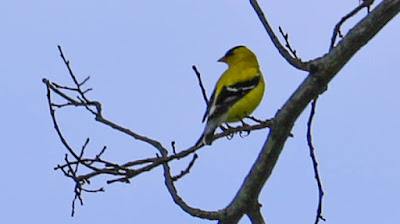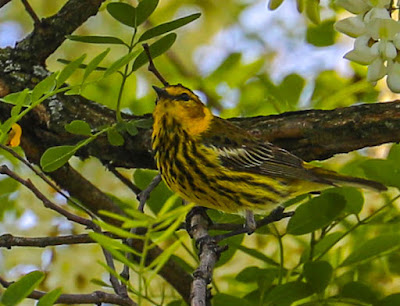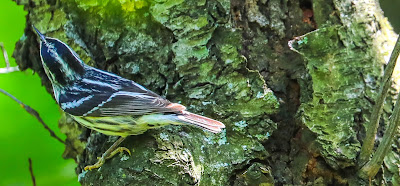On May 12 Judy and I were in New York City to visit one of our sons and his girlfriend. They suggested we go on a bird walk with Birding Bob, but that day led by Deborah Allen. We met at 8:30 a.m. on the north side of the Conservatory Garden which is at 106th Street and 5th Avenue on a path some ways into the Park. We were to walk around the Harlem Meer, then to the North Woods, Wildlife meadow, then the Loch and finish on the west side of the Harlem Meer about 125 yards from the #2 and #3 train station at 110th Street.
Wikipedia notes that Central Park is 843 acres (2.5 miles from north to south and .5 miles from west to east) and gets 42 million visitors a year as of 2016, the most visited urban park in the U.S. I'm stunned to learn it is only the fifth largest park in NYC (Pelham Bay Park in the Bronx is 2,765 acres, Greenbelt on Staten Island is 1,778 acres, Van Cortlandt Park in the Bronx is 1,146 acres and Flushing Meadows/Corona Park in Queens is 898 acres). The Harlem Meer is an 11 acre man-made lake at the northeast corner, west of Fifth Avenue, south of 110th Street and north of the Conservatory Garden. The North Woods is 40 acres and the largest of Central Park's three woodland landscapes. Frederick Law Olmsted and Calvert Vaux who designed it used existing topography, which included hills and large rock outcrops, added trees and vegetation, designed water bodies, cascades, bridges and a network of paths through it. The goal was to create the impression of a rugged wilderness in the heart of the city. The Dene Slope is a 1.25 acre native meadow with a trail that just opened to the public. It is west of the Billy Johnson Playground and south of the Balto statue. It has tall grasses and herbaceous plants and is still several years from where it needs to be to be self-sustaining. The Loch has three waterfalls and is a narrow watercourse that flows through the Ravine in the North Woods. It too was designed and built by Olmsted and Vaux in an existing valley carved out by Montayne's Rivulet. The stream was damned and widened and the valley was deepened with added plantings, bridges and cascades.
We met with about 35 other people which was kind of unwieldly, too many people to hear the leader and lots of jockeying for good photos. But the scenery was amazing and it was the perfect time of year for migrating warblers, birds I've not seen many of.
Following are photos of birds I took on the walk. I would love to go back and do more birding. It was fantastic.
 |
| American redstart |
 |
| Chestnut-sided warbler (this and next) |
 |
| Black-throated green warbler |
 |
| Bay-breasted warbler (this and next) |
 |
| Canada warbler (this and next) |
 |
| Cape May warbler (this and next) |
 |
| Magnolia warbler |
 |
| Black and white warbler (this and next) |
 |
| Blackpoll warbler (this and next) |
 |
| Northern waterthrush |
 |
| Scarlet tanager (this and next) |
 |
| American robin (this and next) |
 |
| House sparrow |
%20Grackle.jpg) |
| Purple (common) grackle (this and next) |
 |
| Gray catbird |
 |
| Canada goose |
 |
| Mallard |
 |
| Eastern chipmunk |
 |
| American goldfinch |
 |
| Eastern wood-pewee |
 |
| Least flycatcher |
 |
| European starling |













%20Grackle.jpg)
















%20Grackle.jpg)
If you want to go back to do more birding in Central Park, I'm game. I'd love to visit a museum with our son while you're peering into the leaves.
ReplyDelete